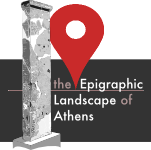Updates #7: Public inscriptions from Ag. Demetrios Katiphoris
by Martina Zerbinati
An eastern section of the Late Roman circuit wall (the so called post-Herulian wall, probably built after the raids of the Herulians in 267/268 BCE) was found in 1861 in the late Byzantine church of Ag. Demetrios Katiphoris, within Athens Plaka’s district. The section of the wall uncovered different types of fragments reused as building materials, such as bases of statues, fragments of sculptures, herms and a large number of honorary and ephebic inscriptions. References to the Diogeneion found in many inscriptions together with mentions to the Theseion and the Ptolemaion in some other fragments discovered in the area of Katiphoris led the scholars to suppose that the gymnasium of Diogenes, as well as the one of Ptolemy and the sanctuary of Theseus, were located not far from the Post-Herulian fortification wall, even though the exact site of these three monumental buildings can not be defined accurately. Despite this, thanks to the epigraphic and literary evidence, the shrine of Theseus, the gymnasium of Ptolemy and the gymnasium of Diogenes (if not part of the same complex) could be probably located on the eastern side of the Roman Agora, in the area north of the Acropolis. This part of the city was indeed systematically monumentalized during Hellenistic times to such a degree that in the II century BCE it was perceived as the city-centre. This research focuses on the epigraphic documents discovered extra situ in the area of Katiforis, which could be related to the monuments mentioned above and located in the same context, in the attempt to reconstruct the epigraphic landscape of this monumental area.
Martina Zerbinati (Vercelli)
Published on: 21 Nov 2018 by Chiara Lasagni


